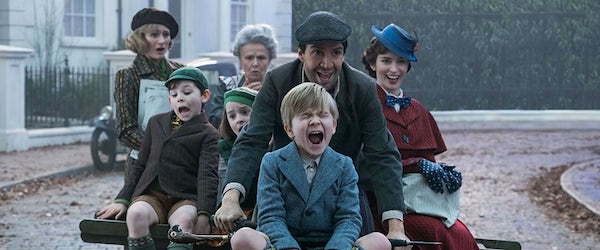
ReelBob: ‘Mary Poppins Returns’ ★★★
By Bob Bloom
“Mary Poppins Returns” is a charming confection, and while it may not be supercalifragilisticexpialidocious, it provides enough merriment, music and magic to warm your heart and keep you smiling.
The movie may not be perfect in every way. However, it succeeds because director Rob Marshall remains within the parameters of expectations — a simple story in which PL Travers’ nanny again helps the Banks family rediscover and reawaken the joy in their lives.
New songs are introduced, which, seem to blur and run together. There’s no “A Spoonful of Sugar” or other ditties from the original,though, snippets of notes from some tunes can be discerned.
The film, set in Depression-era London, finds a grown-up Michael Banks (Ben Whishaw) still living on Cherry Tree Lane. He is a widower with three young children. Michael’s sister, Jane (Emily Mortimer), like her late mother, is an activist; her cause is fighting for higher wages for workers.
The death of his wife has put Michael behind in payments on a bank loan, and he has five days to pay off the loan or lose his childhood house.
The family’s only hope is a certificate proving that the Banks own shares in the bank where Michael’s father, George, once worked — and where Michael now earns his living as a teller.
An old kite of Michael and Jane’s is the instrument that floats Mary Poppins back into the lives of the family.
Emily Blunt glides down to Earth on that kite’s string, and her presence ignites the movie.
Blunt, who costarred in Marshall’s adaptation of “Into the Woods,” brings her own interpretation to Mary. She puts her own stamp on Poppins, while, at times, offering subtle hints of Julie Andrews from the 1964 original.
Blunt has a fine singing voice — though not in the range of Andrews; few people have such a gift. Blunt’s vocals and dancing help lift the movie, which, at 130 minutes, is too long.
Blunt is the movie’s backbone. She is wise, witty and mischievous — with a twinkle in her eye. She is not so much the film’s protagonist, as she is the engine who, with a few words or a gesture, directs people to the right path.
The shadow of Andrews’ “Mary Poppins” hangs over the sequel,but it does not obscure what “Returns” wants to accomplish.
The movie is somewhat dark and sad, as Michael and his children deal with the void in their lives. Mary Poppins basically guides them to a place of acceptance and recognizing that, while some things are gone, they never arereally lost.
The song, “The Place Where Lost Things Go,” is a bittersweet reminder of the process.
Technologically, “Mary Poppins Returns” is impressive because,like the original, it blends live-action with colorful animated sequences — as well as a few scares, which always were a staple of early Disney animated features.
The highlight is a rousing music hall-like number, “You Can’t Tell a Book by Its Cover,” performed by Blunt and Lin-Manuel Miranda, who plays Jack, a lamplighter, who also remembers Mary Poppins from his childhood.
The Banks children — Pixie Davies as Anabel, Nathanael Saleh as John and, especially, Joel Dawson as Georgie — are vibrant and charming.They are your eyes and ears into Mary Poppins’ magical world.
A musical sequence with Meryl Streep as Mary’s cousin, Topsy, is delightful, reminding us of Streep’s versatility and comedic timing.
“Mary Poppins Returns” does try too hard to be buoyant and bubbly. Marshall and his cast expend too much energy to make it all seem effortless.
Yet, thanks to Blunt, as well as Miranda and the children, it is enchanting and infectious.
The film is not lighter than air, but it is breezy enough to lift your spirits.
I am a founding member of the Indiana Film JournalistsAssociation. My reviews appear at ReelBob (reelbob.com) and Rottentomatoes (www.rottentomatoes.com).I also review Blu-rays and DVDs. I can be reached by email at bobbloomjc@gmail.comor on Twitter @ReelBobBloom. Links to my reviews can be found on Facebook,Twitter, Google+ and LinkedIn.
MARY POPPINS RETURNS
3 stars out of 4
(PG) for thematic elements, action